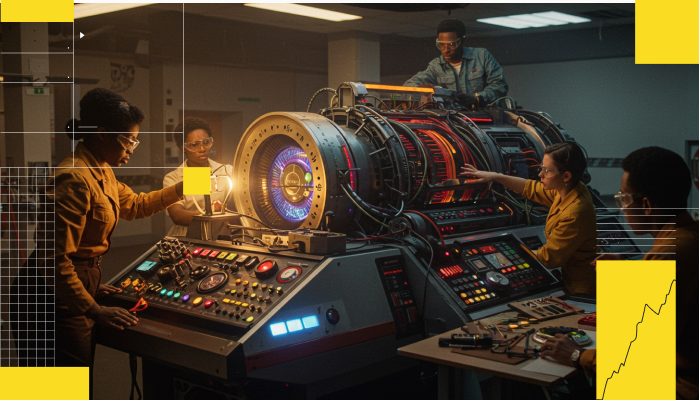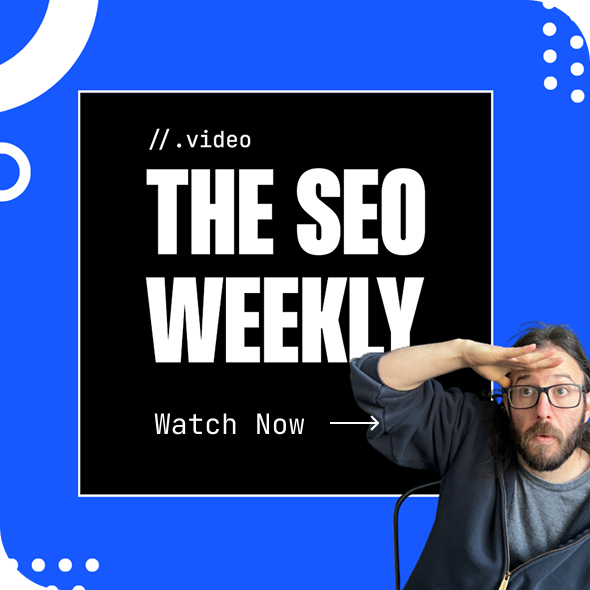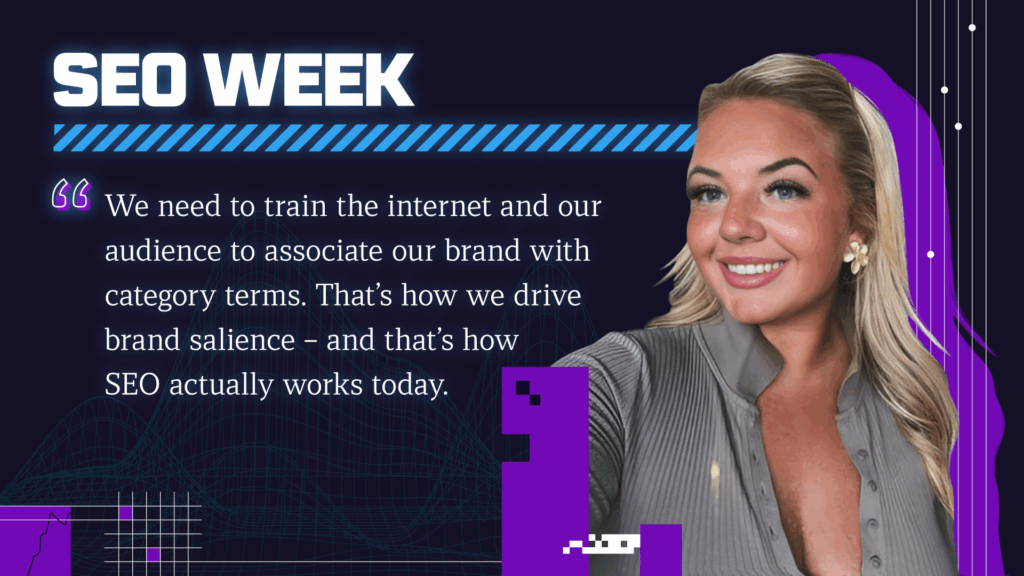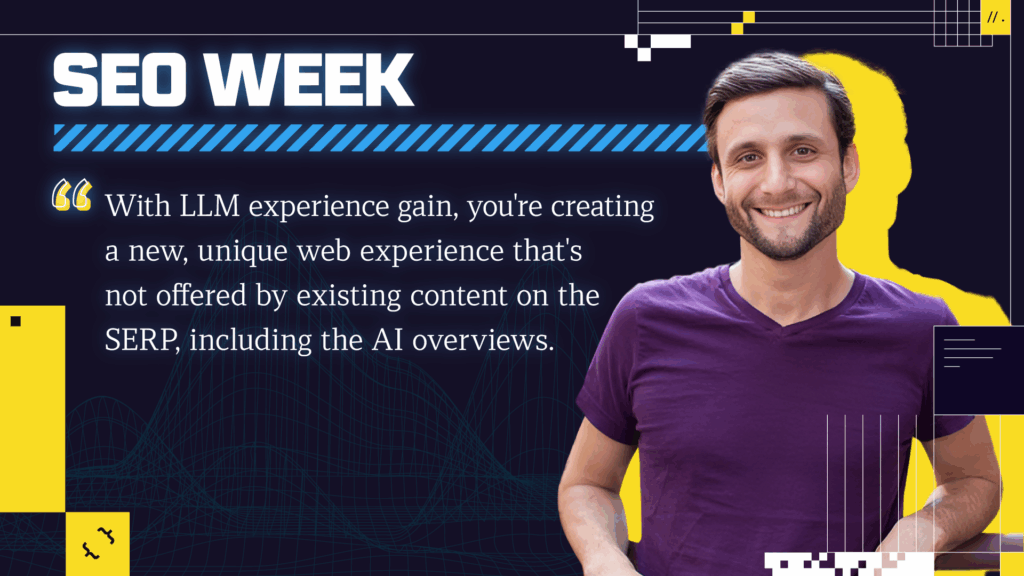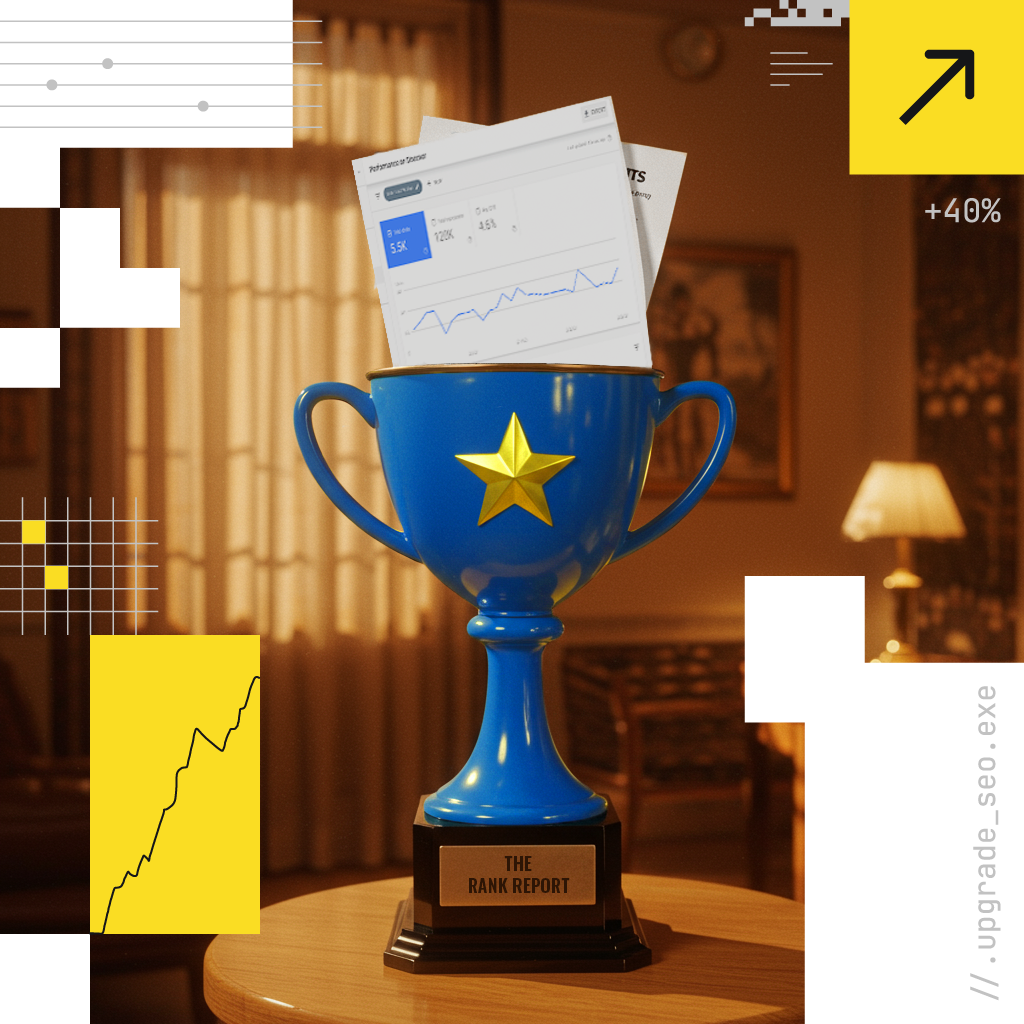If you’d told me a year ago I’d be spending a gorgeous spring week in Midtown Manhattan discussing how AI agents will soon be browsing the internet on our behalf, I probably would’ve laughed. But on the final day of SEO Week NYC, that was exactly the vibe…and somehow, it all made perfect sense. Day 4, themed “The Future,” delivered a high-energy, mind-expanding finale to an already unforgettable week.
This wasn’t your typical wrap-up day. It was kinda like the SEO version of a season finale, packed with bold predictions, new frameworks, and juuuust enough existential dread to make it exciting (and scary? But mostly exciting).

The conversations weren’t about what’s working now; they were about what might work next year, or even next month (and, it turned out, the following week?!). From rethinking traffic and KPIs to prepping for a world of AI agents and zero-click futures, the sessions pushed everyone out of their comfort zones in the best way possible.
Let’s dive right into the review of the content
Jump to the speakers
Download all of the decks from our SEO Week day four speakers
Word to Your MUM

Cindy Krum, CEO of MobileMoxy, talked about how Google’s Multitask Unified Model (MUM) is reshaping search. Far more advanced than BERT, MUM is multimodal – processing images, videos, maps, and text to better understand user intent and context.
Cindy emphasized that AI-generated results, like AI Overviews, are costly for Google to produce—over 100x more than standard queries. To justify the expense, Google is modeling user journeys around entities to anticipate follow-ups and drive monetizable interactions.
The takeaway: SEO must evolve beyond keywords to align with Google’s goals—supporting entity-driven journeys, personalization, and ad conversion. Recent platform changes suggest a move toward a fully integrated, logged-in search ecosystem.

"We optimized for keywords, then we optimized for entities, and now we have to optimize for MUM journeys.”
- Cindy Krum
Key points
- MUM as the Engine Behind the Next-Gen Search: MUM is central to Google’s vision of search that’s conversational, predictive, and personalized. By integrating data from various formats (text, images, video, maps), it provides context-rich answers and models entire journeys based on entities, not just keywords. This enables Google to offer more accurate, multimodal responses at scale.
- AI Overviews Are Expensive, and Monetization is the Goal: Generating AI Overviews is 100 times costlier than traditional results. Google offsets this cost by mapping user behavior into monetizable micro-moments – like “I want to know” or “I want to buy”- and pairing them with its revenue-generating products (Search Ads, Maps, YouTube, Merchant Center).
- Query Fan-Out and Qforia in Action: Cindy referenced Google’s use of query fan-out, a process where multiple sub-queries are dispatched across different data sources to synthesize the best response. This technique, part of Google’s Gemini and AI Mode architecture, matches the MUM framework, efficiently serving rich, relevant answers with less redundancy. Qforia, Google’s internal system for optimizing AI queries, likely plays a role in orchestrating these multifaceted responses.
- Micro-Moments Drive Search Strategy: Google’s monetization hinges on classifying searches into four core “micro-moments”: I want to know, go, do, or buy. Understanding which of these buckets your content falls into allows you to better align with Google’s business objectives, and potentially gain better placement in AI-generated results.
- The Rise of Journey-Based SEO: We’re shifting from keyword and URL optimization to journey and entity-based optimization. SEOs must now identify key entities they want to own, understand user behaviors around those entities, and create content that supports each step in that journey, from initial curiosity to final conversion.
- Hyper-Personalization Will Break Traditional Ranking Models: Cindy cautioned that with Google’s increasing personalization, based on device, location, language, and login state, standard SEO metrics like rank tracking are becoming unreliable. Instead, SEOs will need to rely on behavioral insights, engagement signals, and personalized testing to evaluate success.
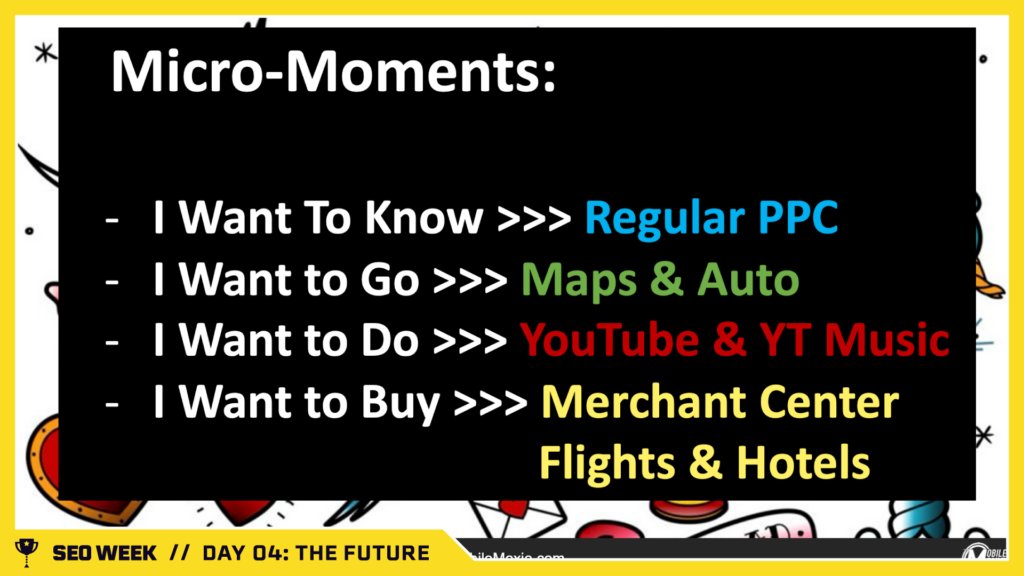
Important Takeaway
The era of search is being reshaped by AI and economic imperatives. MUM is not just a technical innovation, it’s a strategic pivot in how content is evaluated, surfaced, and monetized. For SEOs, success will depend on anticipating Google’s next move and aligning content not only with search behavior, but with the business model driving it.
Mini Glossary
- MUM (Multitask Unified Model): Google’s advanced AI model designed to understand information across multiple formats, enabling it to deliver context-rich, conversational, and predictive search results. 1,000x more powerful than BERT.
- Entity-Based Journeys: A new SEO framework in which user behavior is modeled around “entities” (people, places, things). Google anticipates and maps follow-up queries to serve more targeted, efficient search experiences.
- Query Fan Out: A process where Google issues multiple sub-queries across different topics and data sources simultaneously. The results are aggregated and synthesized into a single, AI-generated answer.
- Qforia: A likely internal Google system used to orchestrate and optimize AI queries across sources in real time. Though not officially confirmed, it may help power the fan out architecture of AI Mode and Gemini.
Executive Presence: How To Get Buy In and Budget For SEO

Tom Critchlow, EVP of Audience Growth at Raptive, delivered a powerful talk on how executive presence matters more than technical SEO when it comes to securing buy-in. While many SEOs focus on tactics, few know how to communicate value to leadership. That gap inspired him to launch the SEO MBA, focused on developing leadership, communication, and strategic planning skills for SEOs.
Tom emphasized that traditional SEO reports often miss the mark with executives. Instead of keyword data, leaders want to understand business impact. He recommends using tailored “input metrics” – leading indicators like expert-reviewed content or Core Web Vitals compliance – that align with company goals and make SEO efforts tangible and fundable.
The core message: SEOs must move from doing SEO to enabling it, by learning to speak the language of executives.
“The number one challenge organizations face getting SEO outcomes is not SEO knowledge - it’s getting buy-in, budget, and executive sponsorship. Reporting isn’t just about showing what happened; it needs to answer the question: ‘What would you do with an extra million dollars?’"
- Tom Critchlow
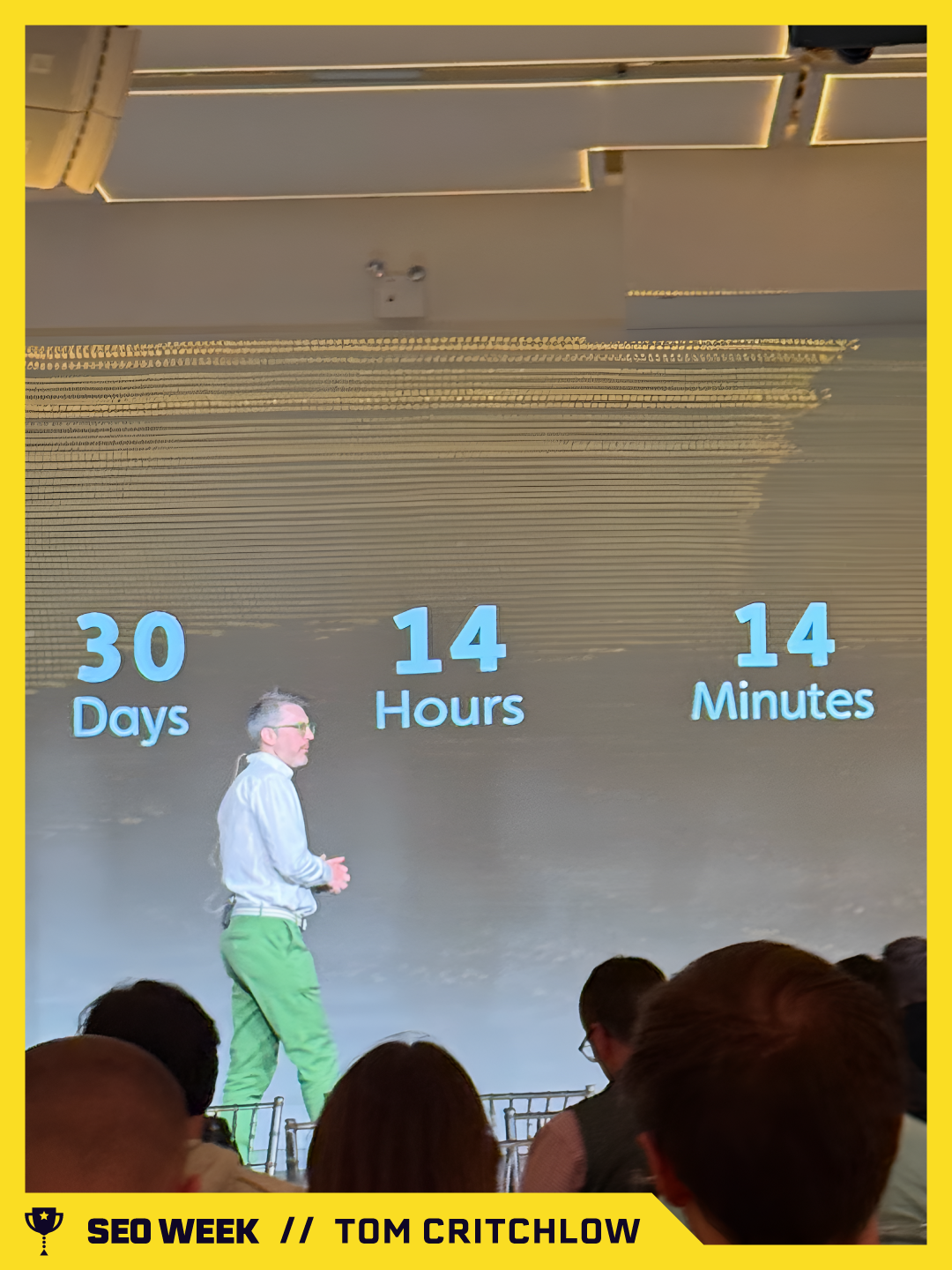
Key points
- Organizational Buy-In Is the Real SEO Challenge: The primary obstacle to SEO success is not technical knowledge but a lack of executive support, budget, and organizational alignment. The most effective SEO professionals are those who can influence stakeholders and gain internal buy-in, not just optimize title tags or site structure.
- Input Metrics Over Lagging Indicators: Traditional SEO reporting focuses too much on lagging indicators like traffic or rankings. Instead, go for “input metrics” – controllable actions that predict future success (e.g., articles published, schema implemented). These help answer executive questions about where money went and what actions were taken.
- Reporting as Executive Communication: SEO reporting should act as a strategic communication tool to inform executives, answer questions about ROI, and propose future investment opportunities. Reporting that fails to speak the executive’s language (strategy, budget, risk, and opportunity) will be ignored.
- Custom Metrics Built on Expertise: Effective input metrics are not off-the-shelf; they must be crafted based on organizational context and expert SEO knowledge. For instance, “content quality” might be broken into measurable elements like freshness, word count, or presence of citations. This turns fuzzy concepts into actionable data.
- Input Metrics Must Evolve Over Time: Just like product and marketing KPIs, input metrics should be iteratively refined to better reflect business goals. Amazon’s evolution from “page views” to “page views on fast-shipping items” illustrates how businesses can align metrics more closely with outcomes over time.
- Executive Presence Is a Career Accelerator: The SEO MBA, which teaches these strategic and communication skills, has helped many professionals secure leadership roles. By learning how to influence, budget, and report effectively, SEOs can both project wins and advance their careers while holding organizational influence.
Important Takeaway
To drive meaningful SEO outcomes, professionals must shift from technical execution to strategic influence, mastering input metrics and treating reporting as a tool for executive alignment. Success hinges less on knowing SEO tactics and more on answering the question: “Where did the money go, and what should we do next?”
Mini Glossary
- Input Metrics: Proactive, controllable metrics that reflect the work being done (e.g., articles published, schema applied). They help predict future performance and communicate effort and direction to executives.
- Lagging Indicators: Outcome-based metrics like organic traffic or keyword rankings. These reflect what has already happened and don’t always show what actions caused the results.
- Metric Evolution: The process of refining and iterating input metrics over time to better represent what drives real business outcomes. A sign of maturity in analytics and operational alignment.
Beyond Rank Tracking: Analyzing Brand Perceptions Through Language Model Association Networks

Dan Petrovic, Managing Director of DEJAN, introduced a new way to measure brand visibility within LLMs. Instead of tracking keywords, he uses bidirectional queries to map brand-entity relationships, focusing on frequency and volatility to assess authority.
Dan developed a scoring system combining average rank and mention frequency, then visualizes brand influence using graph-based tools like PageRank. This reveals how central a brand is in an LLM’s knowledge network.
He advocates for “dual optimization”: shaping both content and user prompts to influence LLM outputs, even embedding prompt templates within brand content. Dan also shared a free tool to predict when LLMs will use internal knowledge vs. search, which is crucial for targeting optimization. This framework opens new paths for brand strategy and competitive analysis in the LLM era.
“Frequency is an expression of strength of brand-to-entity association in the model...volatility level is an inverse expression of brand authority. High oscillations, low authority. Low oscillations, high authority.”
- Dan Petrovic
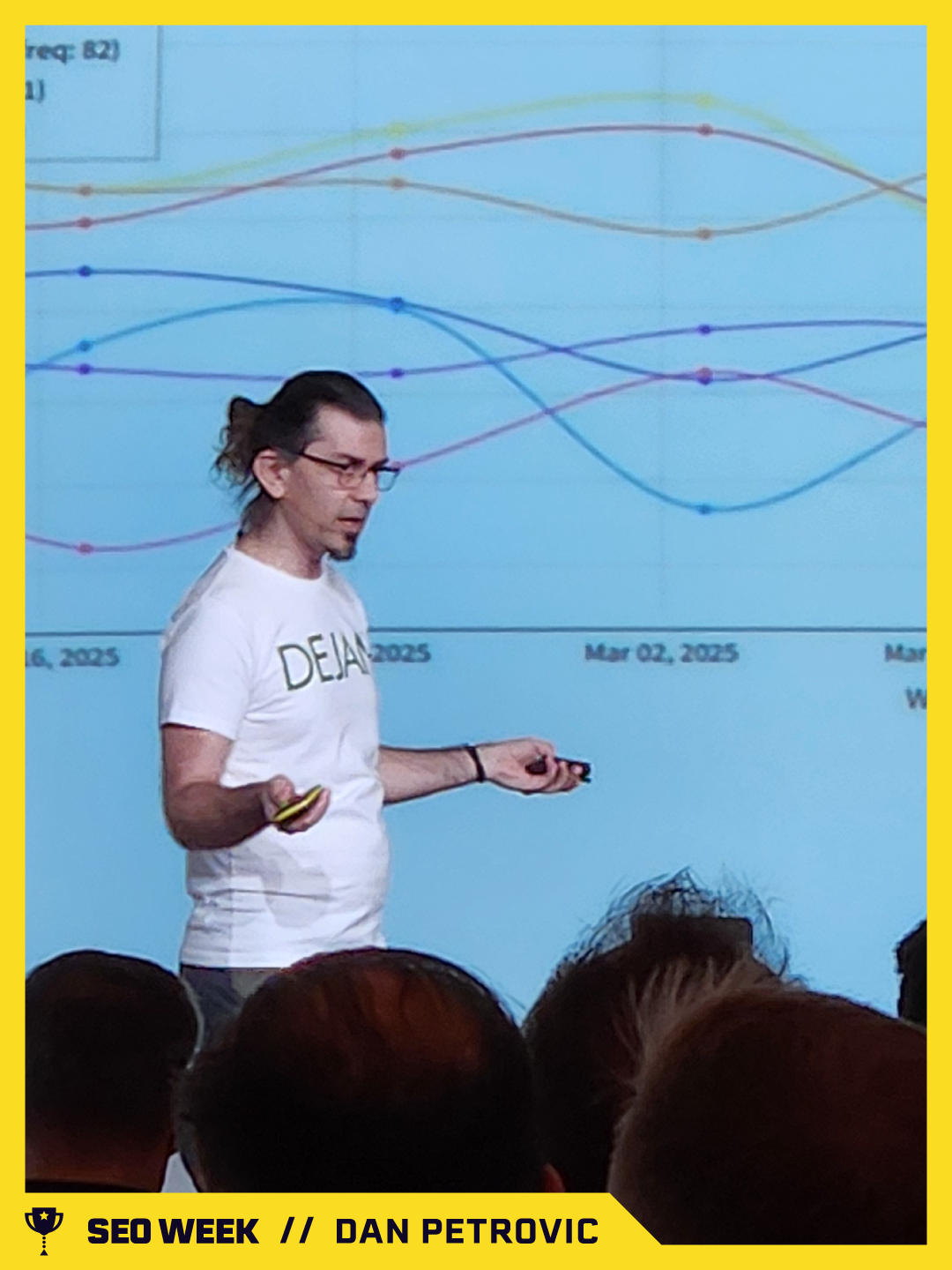
Key points
- Bidirectional LLM Querying: A sophisticated method where LLMs are asked to link brands to entities and entities back to brands. This process, captured in structured JSON format, builds a rich web of data for analyzing how a brand is represented conceptually within the model.
- Volatility as Brand Authority Indicator: Frequency of brand mention indicates association strength, while lower volatility in completions signals higher brand authority. Consistency of LLM responses over time becomes a key metric in evaluating brand imprint.
- Graph ML and PageRank for Influence Mapping: Structured data is transformed into influence networks. Using graph theory, brands can identify the most influential nodes in an LLM’s knowledge graph, thereby offering deeper competitive insights and content opportunities.
- LLM Training Mechanics as a Tactical Lever: Masked Language Modeling and transformer attention layers explain how brands can engineer content to align with how LLMs interpret relationships, going beyond keywords to semantic context shaping.
- Dual Optimization Opportunity: Brands can strategically structure content to trigger desired LLM responses and guide user prompt behavior by embedding “prompt recipes” in published content. This turns passive readers into brand advocates in AI interactions.
- Competitive Intelligence via LLM Analysis: The framework isn’t limited to self-analysis. Brands can survey how competitors are perceived by LLMs, gaining unseen insights into rival strengths, associations, and vulnerabilities in the AI information ecosystem.
- Grounding Prediction Tool: A free model predicts whether LLMs will answer using internal knowledge or external search, enabling targeted strategies for ungrounded prompts, where LLM-native influence tactics are most powerful.
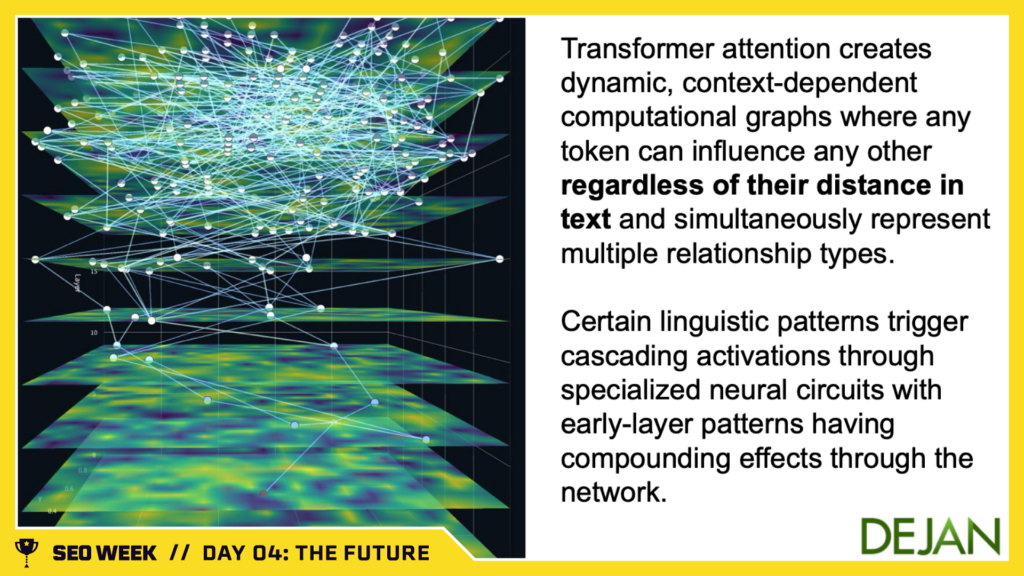
Important Takeaway
This framework signals a transformative shift for SEOs and digital strategists: from optimizing for search engine results to optimizing for AI perception and language model influence.
Mini Glossary
- Bidirectional LLM Querying: A method of prompting LLMs to list entities associated with a brand and brands associated with an entity. This dual approach builds a comprehensive dataset of conceptual associations.
- Graph ML (Machine Learning): A method for mapping relationships between brands and entities using graph theory. Applying algorithms like PageRank reveals which entities or brands are most central and influential in the LLM’s knowledge network.
- Grounded vs. Ungrounded Queries: A grounded query triggers a real-time web search; an ungrounded one is answered using the model’s pre-existing internal knowledge. Knowing the difference helps tailor optimization efforts for better visibility.
AI's Impact on Media and PR SEO

Lexi Mills, CEO at Shift6, examined how AI is reshaping journalism and PR. She warned that emotional paralysis can prevent professionals from adapting to change and stressed the need for curiosity and composure in the AI age.
Lexi traced the shift from SEO-driven journalism to AI-powered newsrooms, where tools like Bloomberg’s Cyborg prioritize speed over accuracy, making human verification more valuable. As PR and SEO converge, she emphasized the need for technical skills in PR, including pitching to AI, optimizing FAQs, and navigating affiliate networks.
Lexi’s core message is that in a trust-based economy, authenticity wins. Tactics like expert profiles, consistent branding, and even subtle human touches (like typos) can boost credibility. Strategic PR can still shape markets, AI or not.
“PR and SEO are moving closer together than ever before. We need to build trust around brand, around product, around team…and we need to think beyond optimization of just websites. We have to optimize all the real estate that builds trust.”
- Lexi Mills
Key Points:

- Pitching to Machines Is the New PR Frontier: AI-powered tools are now writing and influencing news. PR professionals must adapt by creating optimized, clear, and trustworthy news sections on client sites. AIs prefer structured data and exact-match terms, so building for them means proactively training models to recognize your brand as credible.
- Build Expert Trust and Digital Footprints: Journalists and AI models alike are vetting the people behind the content. This means robust LinkedIn profiles, consistent naming across platforms, and ownership of expert-branded domains (e.g., leximills.net) are crucial. Trust is no longer optional; it’s a prerequisite for visibility in LLMs.
- Combine Human and Machine Tactics for PR Wins: Strategic use of trusted news wires can gain instant SERP visibility and help establish credibility before competitors react. Press releases, when distributed to the right feeds, can drive media attention and even shift financial indicators like token prices – especially when layered with traditional PR.
- Media Distribution Has Changed: Go Multimodal, Go Social: Direct traffic to publications and even Google as a news source is waning. Social platforms like TikTok are gaining traction as primary access points. Success in this landscape requires creating video, audio, and written content, packaged and distributed with platforms like Bloomberg and TikTok in mind.
- Monitor AI Journalism Tools like Cyborg and Radar: Tools like Bloomberg’s Cyborg prioritize speed over accuracy, often producing initially flawed content. PRs now play a vital role in providing the “human sense-check.” Google’s Radar, meanwhile, shows that AI-generated content can be both fast and front-page worthy, if quality and credibility are prioritized.
- Human Touch Still Wins: Typos Increase Credibility: In a surprising experiment, Lexi’s team added typos to AI-written PR pitches, resulting in a 20% increase in journalist acceptance. The reasoning? Human imperfection is now a signal of authenticity. This reflects a broader truth: in an AI-saturated world, realness resonates.
- We’ve Entered a Trust-Based Economy: The traditional attention-grabbing tactics of digital marketing are no longer sufficient. Trust, built through credible sources, visible experts, and high-quality coverage, is what determines influence and visibility, both in media outlets and LLM outputs.
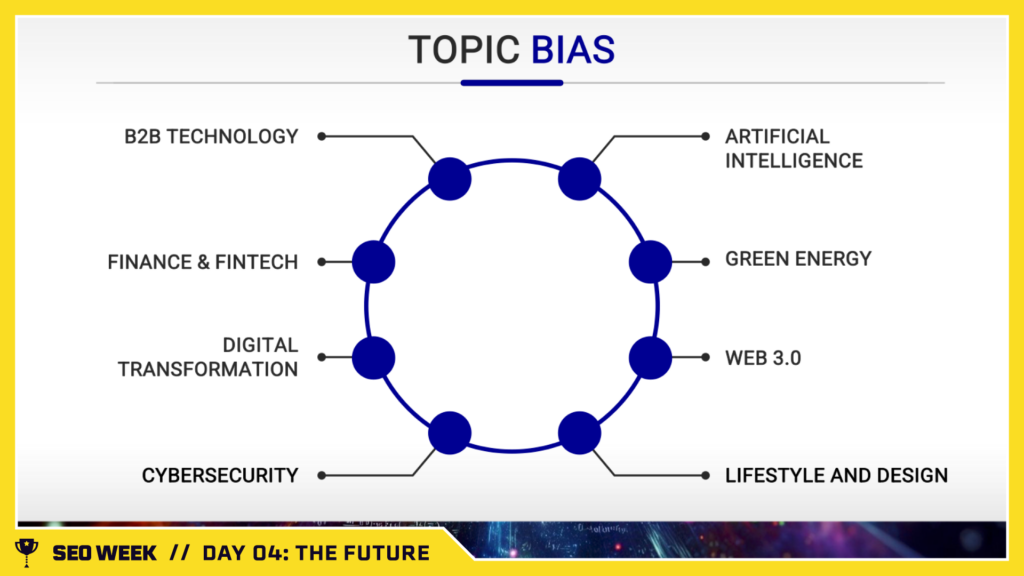
Important Takeaway
In the evolving media landscape dominated by AI, trust has become the most critical currency for both human journalists and language models. PR professionals must now go beyond attention-grabbing tactics to strategically build and showcase authenticity, expert credibility, and optimized digital footprints in order to gain visibility and influence in a trust-based economy.
Mini Glossary
- AI Journalism: The use of artificial intelligence to generate news content, often prioritizing speed over accuracy. Examples include tools like Bloomberg’s Cyborg and the Radar project by the Press Association.
- Pitching Machines: The practice of optimizing content and digital presence (e.g., news sections, About pages) specifically to be discoverable and trusted by AI systems and LLMs.
- Multimodal Journalism: Journalism that integrates various media formats to enhance content richness and discoverability, especially important for AI indexing and audience engagement.
- Celebrity Chef Effect: A phenomenon where publications use well-known figures to front content originally created by others, complicating PR efforts by obscuring the actual content creators.
- Reputation Marketing: The strategic promotion and maintenance of credibility for individuals and brands across digital channels to improve trust with journalists and AI systems.
- Robojournalists: AI-driven tools or systems that scan digital platforms like Twitter to automatically generate and publish news stories.
You Are Bigger than SEO

Rand Fishkin, founder of SparkToro and co-founder/CEO of Snack Bar Studio, urged marketers to move beyond traditional SEO and focus on influence over traffic. As Google shifts toward zero-click searches and AI summaries, SEO must evolve. Rankings matter less if users never visit your site.
Rand stressed that success now means reaching audiences where they already spend time, even on “rented land” like social platforms. Despite Google’s growth, outbound traffic is shrinking, and AI tools aren’t yet viable traffic sources.
Rand is clear that SEOs must become influence builders and adapt strategies to changing user behavior, not outdated traffic metrics. He wants us to become “more” than SEOs: behavior changers, influence builders, and agile strategists capable of navigating a fast-evolving digital world.
“Your new job… is to change behavior, not increase rankings."
- Rand Fishkin
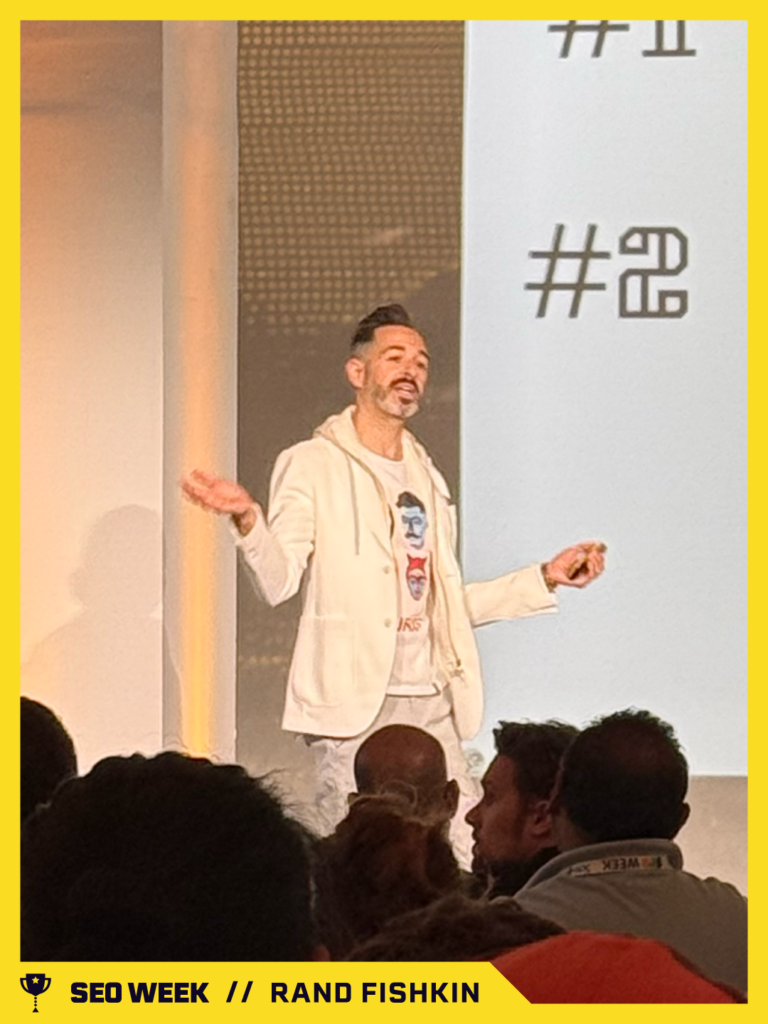
Key points
SEO Must Evolve Beyond Traffic Metrics: Traditional SEO tactics like link building and keyword stuffing are no longer sufficient. With Google’s algorithm and user behavior evolving, traffic is no longer the definitive measure of SEO success. SEOs must pivot from being “algorithm manipulators” to “influence architects” who prioritize long-term brand equity and meaningful audience engagement.
Zero-Click Searches Signal the “End of Traffic”: While Google search volumes are up 22% year-over-year, actual clicks to websites are down. Nearly 60% of searches end without a click (due to features like AI Overviews and direct answers), which undermines the traditional value of ranking high in search results. SEOs must rethink how they define success in a world where visibility no longer guarantees visits.
AI Tools Aren’t (Yet) Replacing Google: Despite the hype, AI tools like ChatGPT process a fraction of Google’s search volume – just 1/373rd, to be precise. Moreover, most AI interactions are non-search-related (e.g., coding, creative tasks). We shouldn’t over-prioritize optimization for these tools at the expense of proven discovery channels, but instead understand their distinct role and trajectory.
Digital Platforms Are Hoarding Traffic: There’s a critical shift happening where platforms are increasingly incentivized to keep users within their ecosystems. Whether it’s Google’s AI summaries, YouTube embeds, or Facebook video, outbound links are being suppressed in favor of user retention. This means marketers must adapt by prioritizing presence and engagement on these platforms, even if it doesn’t generate direct website visits.
Shift from Traffic to Influence: Citing HubSpot’s example of stable revenue despite an 80% traffic drop, Rand illustrates that influence, not traffic, is the more reliable KPI. Marketers must measure brand search lift, engagement, and audience interest instead of mere clickthroughs. Influence drives search intent and conversions, often upstream of measurable site visits.
Strategic Use of “Rented Land” is Now Necessary: Rand now recognizes third party platforms’ unmatched reach and influence. Platforms like LinkedIn, Reddit, and YouTube are where people spend time, and that’s where brands need to be. We need to embrace the risk of dependency in exchange for real-time influence and visibility, treating these platforms like distribution channels, not traffic sources.
Audience Research Is Mission-Critical: The most important shift is mindset: we have to stop assuming our own behavior matches our audience’s. We may love ChatGPT, but that doesn’t mean landscapers or PR pros do. Constant audience research to guide budget allocation and platform strategy is vital to ensure marketing efforts align with real attention patterns, not assumptions.

Important Takeaway
The role of SEO and digital marketing is fundamentally shifting from chasing traffic to building influence. As search engines, especially Google, increasingly answer queries directly through AI Overviews and featured snippets, the number of clicks to external websites is steadily declining. Marketers must adapt by meeting audiences where they already spend time – on social media platforms, video channels, and inside ecosystems like Google and AI tools – even if those platforms don’t directly send traffic.
Mini Glossary
Zero-Click Search: Search results where users find what they need without clicking through to a website, due to featured snippets, knowledge panels, or AI Overviews directly answering queries.
Rented Land: Third-party platforms like LinkedIn, Reddit, YouTube, or TikTok where marketers build visibility despite not owning the distribution channel, acknowledging the risk but leveraging their reach.
Channel Hoarding: A trend where major platforms retain users within their ecosystem rather than sending referral traffic out, often motivated by monetization and engagement goals.
Traffic Apocalypse: A term referencing dramatic declines in organic search traffic (e.g., HubSpot’s 80% drop) without corresponding revenue loss, illustrating the decoupling of traffic and business success.
LLM Experience Gain: How We Climbed the Animal SERPs with a Text-based Gen AI Game

Zack Notes, founder of Sandbox SEO, shared the journey of Animal Matchup – an AI-powered, interactive storytelling site born from a programmatic SEO experiment. What began as a playful project turned into a scalable platform featuring thousands of unique landing pages about hypothetical animal battles, driven by GPT-4 and real-time user interaction.
The site has launched over 200 iterations, now earning 84% of its traffic organically and surviving eight Google core updates. Rather than relying on AI-generated text alone, Animal Matchup incorporates polls, GIFs, tables, and interactive UIs, all supported by strong E-E-A-T practices like fact-checking, citations, and expert input for critical content.
High-performing AI content isn’t about volume, it’s about crafting meaningful, session-based experiences users want to engage with.
“The main three things: personalization, live GenAI text, and user choices - these are the tools that you can use, or your product managers can use, to build features that improve the website and offer experience gain in the SERPs."
- Zack Notes

Key points
- Animal Matchup’s Transformation from SEO Experiment to Interactive Game: Originally built to test AI content generation at scale, Animal Matchup has morphed into a full-fledged interactive experience. It now allows users to create their own hypothetical animal battles with real-time, AI-generated fight stories—effectively becoming a “video game” rather than a static content site. This unexpected pivot highlights the potential of AI to create dynamic, entertainment-first experiences that drive sustained engagement.
- Slow and Steady Wins the SERP: Surviving 8 Core Updates: Despite the high volatility faced by many AI-driven sites, Animal Matchup has maintained and grown its organic traffic. This can be attributed to smart content structuring – avoiding long-form AI text in favor of smaller, digestible blocks, and embedding them within diverse, multimedia-rich layouts. This approach signals to search engines that the site is valuable, usable, and trustworthy.
- “LLM Experience Gain”: The New SEO Differentiator: Interactivity, personalization, and live GenAI content form the future of competitive web experiences. Using LLM APIs, Zack builds generative user flows where inputs lead to new, session-based outputs, offering more utility than static search results or even chatbots. This methodology allows brands to stand out by offering unique, useful, and immersive experiences.
- Embedding E-E-A-T into AI Content Strategy: Trust is paramount. Despite being almost fully AI-generated, Animal Matchup integrates credibility by hiring expert consultants (like a wildlife biologist), creating co-authored content, and linking to author credentials via Google Scholar. Pages most visible to users and bots are manually fact-checked, and source citation is treated as a first-class priority, ensuring alignment with Google’s content quality standards.
- Tools & Tech for Scalable AI Ops: To manage thousands of AI-generated pages and assets, Notes built a custom CMS that streamlines image creation using LLM APIs. Firebase serves as a user-friendly backend ideal for non-technical team members like fact-checking VAs. Additionally, GPT for Sheets plays a key role in scaling copy efficiently, allowing prompt management, cost control, and easy updates without accidental regeneration.
- Generative UX: Better Than Chatbots, Built for Humans: The site’s success hinges on UX choices that prioritize button-based interactivity over clunky text interfaces. Users don’t want to scroll through chat history – they want choices, instant gratification, and immersive visuals. These principles aren’t just useful for animal matchups, they’re applicable to SERPs across industries, from travel planning to recipe sites.

Important Takeaway
Interactivity, personalization, and live AI-generated content (“LLM Experience Gain”) are key to building web experiences that outperform static content and AI overviews—offering users value that search engines are increasingly rewarding.
Mini Glossary
- Live GenAI Text: Content generated in real-time via LLM APIs based on user input or session data. This text is created during the user’s visit, allowing for highly customized experiences, though it may not be immediately visible to search crawlers.
- E-E-A-T (Experience, Expertise, Authoritativeness, Trustworthiness): A Google quality standard for evaluating content.
- Static AI Content: AI-generated content that is pre-written and saved in a database before a user visits the page. Contrasted with live GenAI content, this is what many traditional AI-content websites rely on, but it’s more vulnerable to search penalties if not well-integrated.
From Clicks to Connections: How Content Strategy is Redefining Engagement

Fajr Muhammad, VP of Content Strategy and Growth here at iPullRank, had one central argument: Traditional engagement metrics like clicks and page views are no longer enough to capture real audience interest or build lasting relationships. In today’s “attention recession,” more content often means less connection. With AI overviews and zero-click searches on the rise, clicks are harder to earn but more valuable than ever.
Fajr called for a shift from superficial engagement to meaningful, lasting interactions. Her solution is to rethink how we measure engagement, focus on content that truly earns attention, and optimize post-click experiences.
At the core is her REAL framework (Resonant, Experiential, Actionable, Leveraged) and a new approach called Resonance Design, where SEO, content, and UX combine to create emotionally impactful experiences.
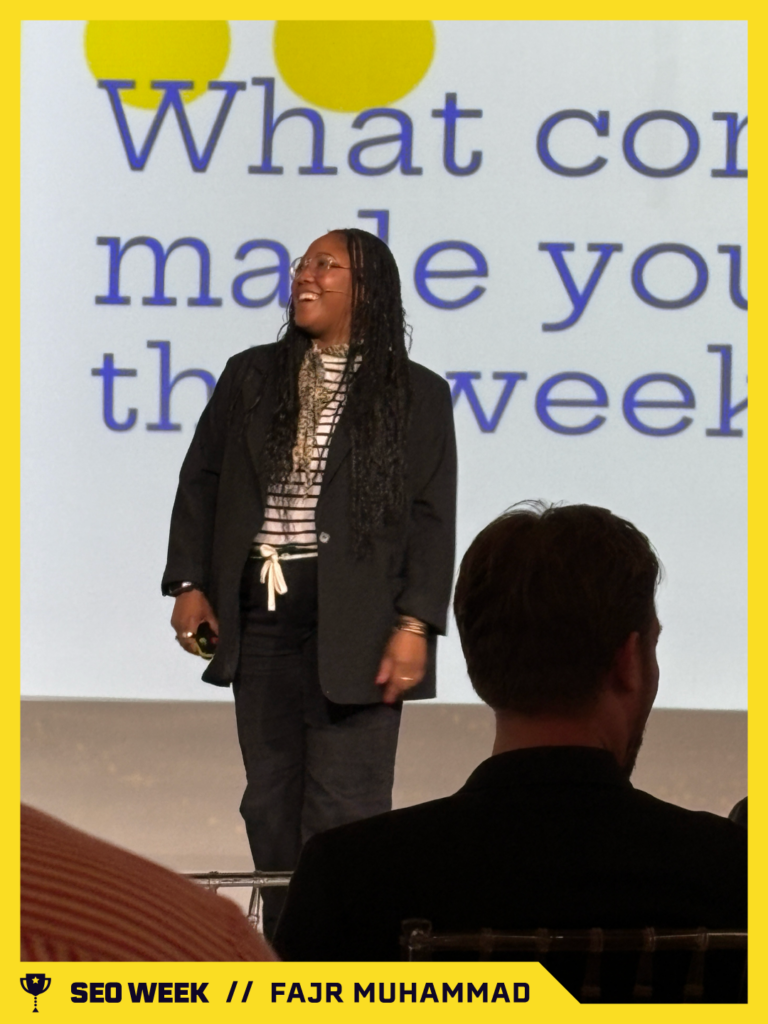
“We’ve created a content problem...more content doesn’t mean more attention - it actually means the inverse. And if we want attention, we’re going to have to earn it differently."
- Fajr Muhammad
Key points
- Clicks Don’t Equal Connection: The belief that clicks alone indicate engagement is outdated. In today’s digital ecosystem, defined by AI overviews and zero-click results, a click is just the beginning, not the end goal. Real success lies in forging deeper connections and building community, not in chasing fleeting impressions.
- We’re in an Attention Recession: Audiences are overwhelmed, and attention spans are down 70% over the past decade. With millions of pieces of content being published daily, marketers face fierce competition for limited mindshare. To stand out, content must be high-quality, highly relevant, and strategically crafted to resonate—not just to exist.
- Redefine What Engagement Means: Surface metrics like likes or views don’t reveal much about true user interest. Tracking more telling signals: time spent on page, content saves, return visits, and newsletter subscriptions. These metrics offer richer insights into what’s actually working and why.
- Create Content Worthy of the Scroll: In an endlessly scrollable world, content must be engineered to stop the scroll. That means strong hooks, clear messaging, compelling visuals, and immediate value. Content should speak to real audience needs in a distinct, fresh voice—and deliver something worth pausing for.
- Maximize Post-Click Value with Micro-Conversions: Clicks are harder to get, so what you do after matters more. Small, meaningful conversions – like newsletter signups, content bookmarks, or retargeting pixels – help marketers build long-term relationships. It’s not always about the hard sell; it’s about staying connected.
- The REAL Framework: A Blueprint for Resonant Content:
- Resonant: Does it emotionally connect?
- Experiential: Is it immersive and interactive?
- Actionable: Is there a clear takeaway or next step?
- Leveraged: Is it designed for repurposing and distribution?

Important Takeaway
In today’s oversaturated digital landscape, the true measure of content success isn’t the click, it’s the connection. To build lasting engagement, content must be emotionally resonant, immersive, actionable, and strategically designed to hold attention and foster ongoing relationships.
Mini Glossary
- Resonance Design: A strategic approach where SEO, content strategy, and design work in harmony to create emotionally compelling, frictionless user experiences.
- Flywheel Funnel: A modern take on the traditional marketing funnel, recognizing that user journeys are no longer linear. Today’s content consumption is multi-platform, multi-touchpoint, and cyclical – requiring flexible, non-linear content strategies.
Navigating a $14 Million Domain Migration

Andrew Prince, Senior SEO Manager at Rocket, gave us behind-the-scenes look at one of the boldest SEO moves in recent history: the $14 million acquisition and full-scale migration to rocket.com. More than a domain change, it was a fast-paced rebrand aimed at redefining “rocket” from aerospace to homeownership.
With a tight timeline and a competitive keyword, the team executed a layered SEO plan: early domain seeding, internal link building, and custom schema, all within a cross-functional “war room” where SEO led key decisions.
The payoff: Rocket.com launched flawlessly and ranked #1 for “rocket” minutes after its Super Bowl ad aired – a win for both brand and search.
“We wanted to rank for ‘rocket’...just spend 10+ million dollars on a Super Bowl commercial and you're good to go.”
- Andrew Prince
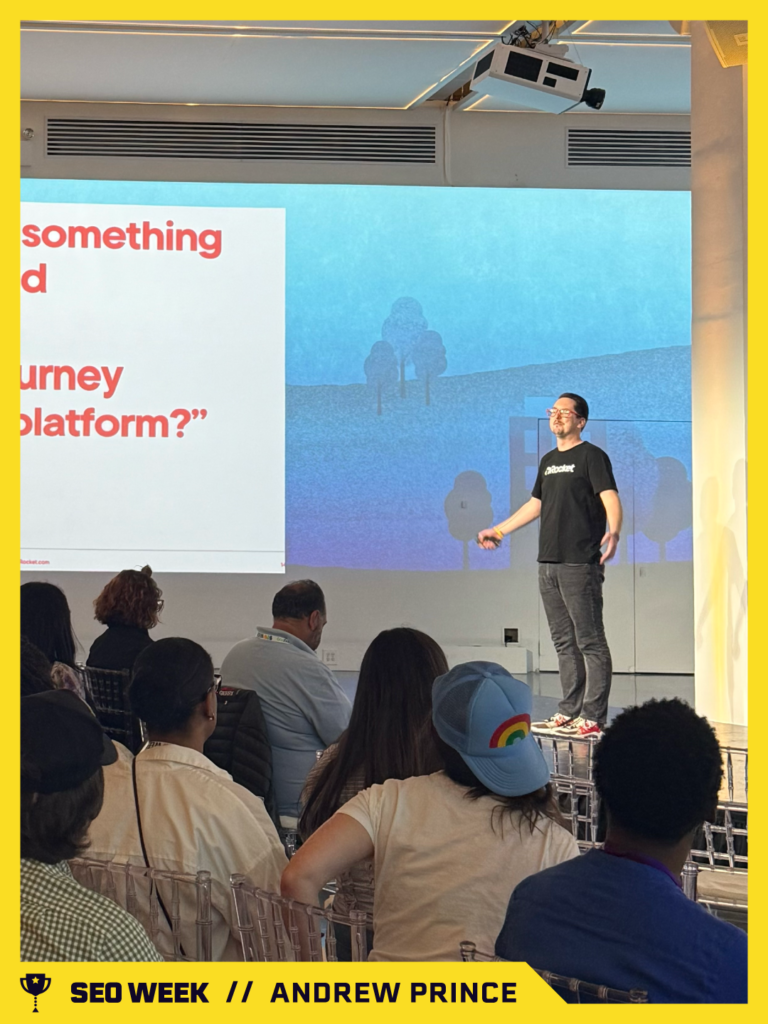
Key points
- A $14M Domain Migration as a Business Statement: Rocket.com wasn’t just a domain, it was a brand bet. The $14 million purchase (4th largest ever) represented a high-stakes investment to unify Rocket’s diverse offerings. SEO played a central role not as a supporting function, but as a strategic driver in executing this market repositioning.
- Timeline: Q3 to Super Bowl = SEO at Warp Speed: With only a few months from purchase to launch, this was one of the fastest turnarounds for a rebrand of this scale. It demanded rapid deployment, QA precision, and organizational alignment, with daily war room meetings across SEO, tech, legal, and product.
- Rewriting Google’s Understanding of “Rocket”: The hardest SEO lift was entity transformation. Previously associated with aerospace, the domain needed to become synonymous with homeownership. This was tackled through early seeding pages, strategic schema, and massive internal linking – all designed to realign Google’s understanding of what Rocket.com now represents.
- SEO Embedded at the Executive Table: Andrew’s SEO team wasn’t on the sidelines; they had decision-making power. From approving headers and URLs to shaping accessibility and technical guidelines, SEO led cross-functional efforts and ensured every element served the brand’s performance and visibility goals.
- Results Within Minutes, Visibility That Lasts: Rocket.com gained 1.4 million in traffic and over a million keywords in the first week alone. Within minutes of their Super Bowl commercial airing, the site ranked #1 for “rocket.” A smartly timed “What is rocket.com” article captured user queries in featured snippets and AI overviews, showing SEO and brand strategy working hand-in-hand.
- Scaling via M&A: The New SEO Frontier: The Rocket.com migration wasn’t the end, it was a launchpad. With strategic acquisitions like Redfin and Mr. Cooper, Rocket is building a full homeownership ecosystem. These moves show how SEO strategy and corporate acquisitions can work in tandem to drive rapid market dominance.
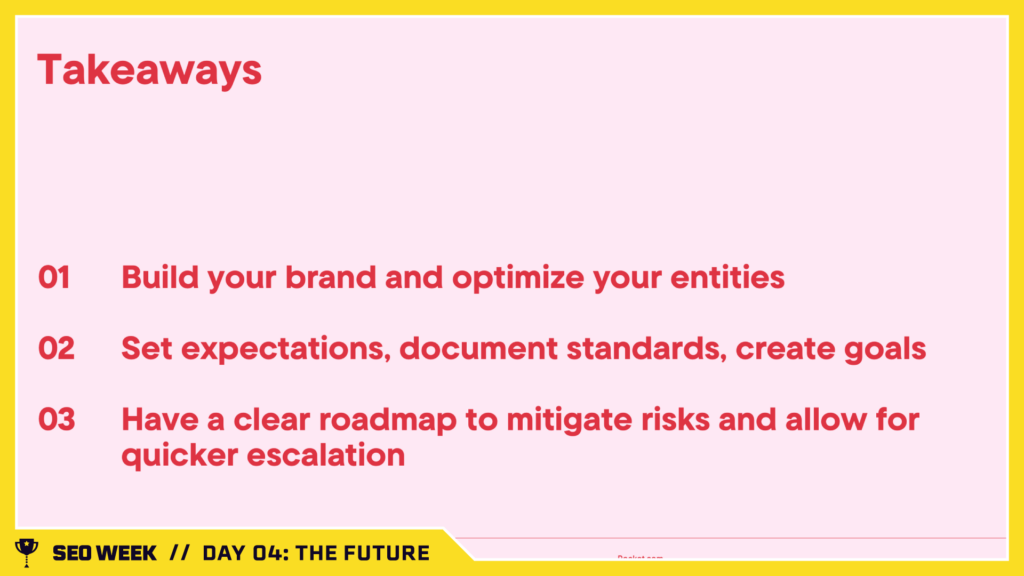
Important Takeaway
When SEO is embedded into core business strategy, with executive buy-in and cross-functional ownership, it becomes a catalyst for transformational brand growth, not just incremental traffic gains. The rocket.com migration shows that with the right structure, speed, and strategic intent, SEO can drive major rebrands, redefine search entities, and unlock massive market visibility.
Mini Glossary
- Entity Shift: A strategic SEO effort to change how Google perceives the identity of a domain.
- Splash Page Seeding: The use of a minimal, early-stage webpage to begin establishing topical relevance and signal a new entity to search engines.
- M&A for SEO: Using Mergers & Acquisitions not just for business growth, but as a deliberate strategy to scale organic search authority, expand user experience offerings, and dominate category SERPs.
When You Can't Beat 'em, Buy 'em : Growing Your Audience Through Strategic Acquisition

Nick Eubanks, VP of Owned Media at Semrush, gave us a roadmap for navigating the rapidly changing digital marketing and SEO landscape. With algorithm volatility, shrinking top-of-funnel visibility, and AI Overviews reshaping how content surfaces, traditional SEO tactics are delivering diminishing returns. Nick’s advicenis to stop fighting for scraps and buy the whole table.
Nick explained how AI-driven changes are decoupling impressions from clicks and breaking attribution models. As Google increasingly pulls from deeper parts of the index and zero-click searches rise, simply ranking well is no longer enough. At the same time, paid acquisition costs are soaring, making organic traffic more valuable but harder to earn.
The solution is to go all in on owned media. Borrowing a page from media companies, Nick recommends that software and service brands acquire their own blogs, newsletters, YouTube channels, or microsites. This approach allows brands to expand their footprint, control more of the search ecosystem, reduce customer acquisition costs (CAC), and increase lifetime value (LTV).
“We’re in a new era of SEO. What used to be Newtonian physics, with clear cause and effect, has now shifted to quantum mechanics. Probability has replaced certainty. And in that uncertainty, owned media becomes one of the few strategic levers we can still control.”
- Nick Eubanks

Key points
- AI is upending traditional SEO logic: The emergence of AIOs and LLMs means Google is increasingly pulling content from page three or deeper, contradicting the long-standing emphasis on page-one rankings. This “decoupling” of clicks and impressions reshapes how marketers must approach visibility and discoverability, demanding more comprehensive and strategic content distribution.
- Paid acquisition is becoming unsustainable: With Facebook CPCs up over 90% since 2020 and other platforms following suit, paid media is no longer the fail-safe growth engine it once was. This economic pressure forces marketers to look toward alternatives that provide more sustainable ROI, like owned assets that drive consistent, qualified traffic.
- Owned media isn’t just a tactic, it’s an ecosystem: Building or acquiring a diverse portfolio of digital properties like blogs, communities, apps, newsletters, podcasts, and video channels should be the new strategy. These assets form a distributed media ecosystem that engages audiences across fragmented digital journeys, especially as user behavior shifts to platforms like TikTok and Instagram.
- Acquisitions unlock exponential growth potential: Rather than relying on incremental gains from on-site SEO, acquiring established digital assets allows brands to rapidly expand their footprint. These properties bring built-in authority, traffic, and audience affinity, significantly reducing CAC and increasing customer LTV.
- Asset value lies in intent-driven traffic: Monetized or not, a digital property’s real value is in the qualified referrals it generates. Nick talks about how to model traffic value based on referral rates, conversion probabilities, and LTV, turning even passive content sites into powerful top-of-funnel assets for customer acquisition.
- The new SEO goal: total SERP dominance: In today’s constrained attention economy, it’s not enough to rank first – you need to own the search results. Acquire and operate multiple top-ranking properties for high-value keywords, creating a “moat” around brand visibility and pushing out competitors.
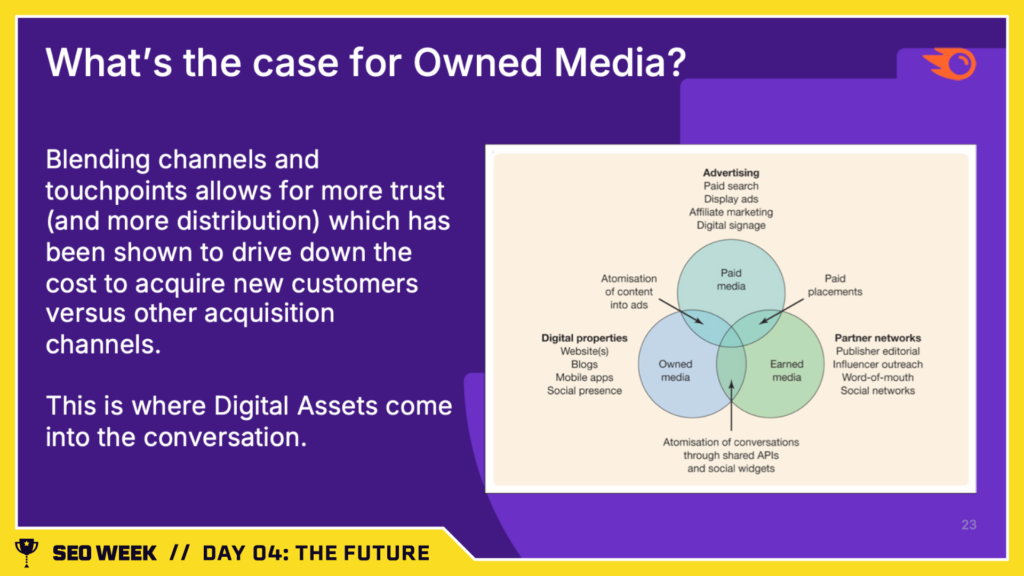
Important Takeaway
The future of effective SEO lies not in fighting for a single top ranking, but in acquiring and operating multiple high-value digital assets to dominate more of the search landscape, reduce customer acquisition costs, and future-proof visibility amid AI-driven changes.
Mini Glossary
Owned Media: Digital properties a brand owns and controls that can drive traffic and build brand authority without relying on ads or search rankings.
CAC & LTV (Customer Acquisition Cost & Lifetime Value): CAC is the cost to acquire a customer; LTV is the total value that customer brings over time. Strategic acquisitions of owned media can reduce CAC and increase LTV by delivering more qualified traffic at a lower cost.
Multiplatform Search Fragmentation: Describes how search behavior is spreading beyond Google to platforms like TikTok, Instagram, Reddit, and YouTube, requiring broader digital presence across channels.
The Vicious Cycle of SEO: How We Got Here & Where We’re Going

Lily Ray, VP of SEO Strategy and Research at Amsive, went through an analysis of the repetitive boom-and-bust nature of SEO tactics, outlining how the industry continually uncovers new ways to exploit search engine algorithms for organic traffic – only for these tactics to become widely adopted, overused, and eventually neutralized by Google.
Lily calls this the “SEO gold rush.” SEOs discover high-impact tactics, which quickly become overused and are eventually neutralized by Google updates. From early keyword stuffing and link schemes to today’s AI-generated and programmatic content, each wave of tactics has triggered a crackdown (most recently through the 2023 Helpful Content Update and the massive March 2024 Core and Spam Update).
Lily advocates for a shift toward “authentic SEO.” As AI Overviews and zero-click results reduce traditional traffic, visibility in LLMs is becoming critical. Future-forward strategies should emphasize genuine expertise, original research, and ethical content creation. She recommends tracking LLM citations and sentiment, building strong personal brands, and repurposing high-quality content across channels to boost authority and reach.
Sustainable SEO now means creating content trusted by both people and AI.
“The history of SEO reveals that the rules are always changing and adaptation is key. Don’t get stuck in the cat-and-mouse game. You’ll eventually get caught. Consider investing in original research, community building, authenticity, and thought leadership."
- Lily Ray
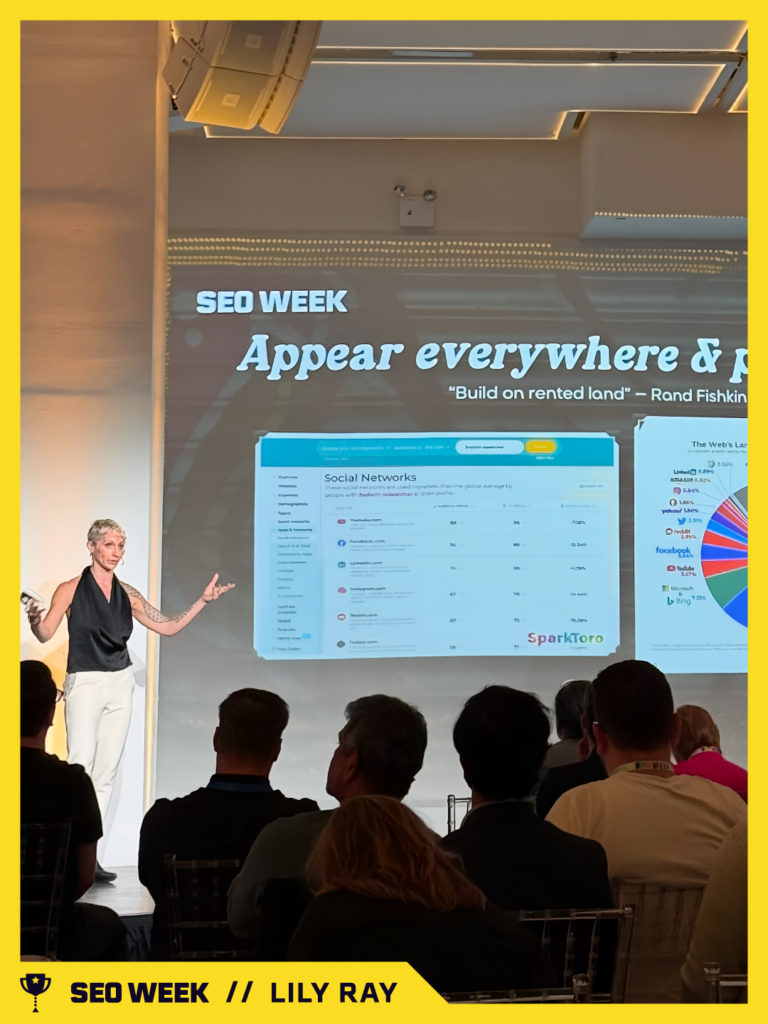
Key points
- Understand and Exit the SEO Exploit Cycle: The SEO industry has historically operated in a repeating cycle of discovery, exploitation, and crackdown. Tactics such as keyword stuffing, AI-generated content, and programmatic SEO initially yield strong results but ultimately degrade user experience and are classified as spam by Google. Sustainable success comes from breaking this cycle and aligning with evolving definitions of helpful, user-centric content.
- Adapt to Google’s Aggressive Anti-Spam Measures: Google’s recent updates – particularly the September 2023 Helpful Content Update and March 2024 Core and Spam Update – represent the most forceful push yet to cleanse the SERPs of manipulative content. Thousands of sites, including large publishers, lost significant visibility and revenue. New policies on site reputation abuse now penalize even indirectly affiliated content, and recovery is extremely difficult, signaling a need for strategic realignment toward quality and relevance.
- Recognize the Impact of AI Overviews on Organic Traffic: AI Overviews and AI Mode on Google dramatically reduce traditional click-through rates, even for top-ranking content. This shift demands a change in SEO KPIs: from focusing solely on traffic and rankings to tracking how brands and content are surfaced, cited, and perceived within LLMs. Visibility, accuracy, and sentiment within these summaries are emerging as new measures of success.
- Redefine SEO Strategy with LLM Visibility and Sentiment: SEOs need to look beyond search rankings and begin optimizing for how they’re represented in LLMs. Tools like Profound and ZipTie help track LLM citations, assess sentiment, and measure citation accuracy. Ensuring data consistency across platforms, surfacing authoritative information, and closing content gaps are now essential parts of SEO strategy.
- Double Down on Expertise, Originality, and Brand Authority: The path forward lies in authentic, high-quality content backed by real expertise. Affiliate sites that succeed today show transparent methodologies, real product testing, and video or photographic proof. Similarly, building strong personal brands for your team’s experts and amplifying their presence across LinkedIn, YouTube, Reddit, and other LLM-prioritized platforms boosts trust and discoverability.
- Avoid New Manipulative Tactics because Sustainability Wins: As LLM visibility becomes more important, unethical strategies, such as bribing cited sources, may emerge, mirroring old-school link manipulation. However, such behavior will inevitably trigger anti-spam responses from Google and OpenAI. Brands should focus on long-term, ethical optimization by leading with value, transparency, and user-first content strategies.
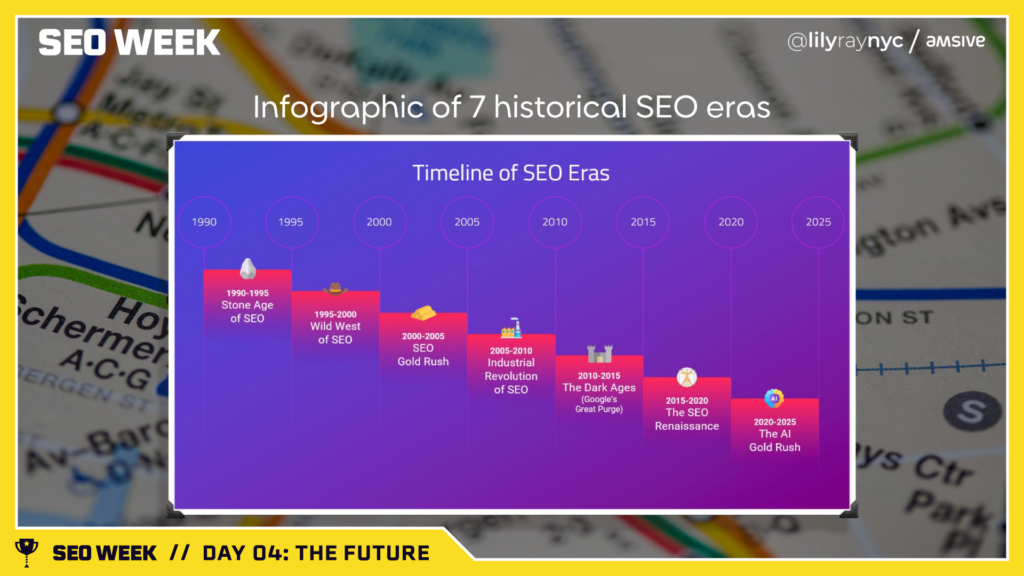
Important Takeaway
The future of SEO lies in moving beyond exploitative tactics and embracing sustainable, ethical strategies that prioritize genuine expertise, original content, and visibility within large language models, because the traditional chase for rankings alone is no longer enough in an AI-driven search landscape.
Mini Glossary
Parasite SEO: Publishing third-party content on high-authority websites (like Reddit, Quora, or news sites) to exploit their ranking power, often without aligning with the host site’s core purpose.
Site Reputation Abuse: Google’s manual action against websites that allow low-quality or irrelevant third-party content to piggyback off their domain authority, even if indirectly affiliated.
And That Was A Wrap on SEO Week…Til Next Year!
What a week. The iPullRank team was so excited and also a little apprehensive about our first big event, and wow…it truly couldn’t have gone any better (except for maybe having better chairs from the start!).
We were all abuzz with talk of changing search behavior, collapsing attribution models, and talking about a new era where content needs to earn not just user attention, but AI trust. Terms like “Agent Experience” and “LLM visibility” started to feel less futuristic and more urgent. We went from talking about SEO to sketching out what it means to be discoverable in a post-keyword world.
From the content to the excitement to the connections to the parties, it was fantastic! And as the curtain closed on SEO Week, the mood stayed pretty energized and inspired. We showed up to discuss the future of SEO and left knowing we’re the ones shaping it, which is pretty amazing.
And, of course, SEO Week 2026 is already on the books. We sold out of 50 super-extra-early bird tickets in a few weeks, and we’re already talking about needing a (much) bigger venue next year. We can’t wait, honestly – and imagine how different things are going to be in another 11 months?! Here’s to trailblazing the new SEO. Thanks to you all!
